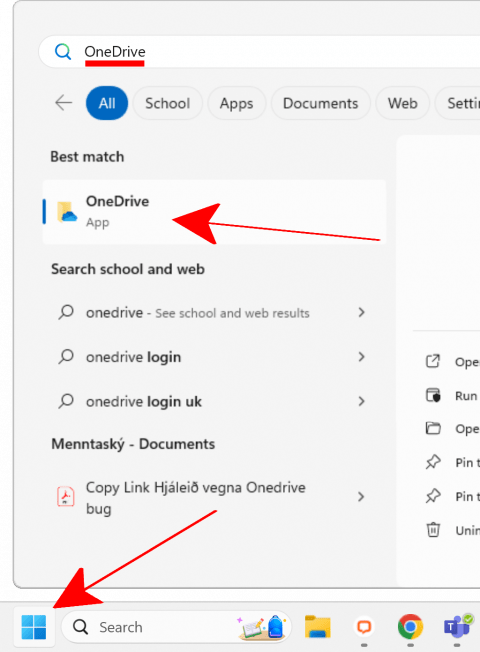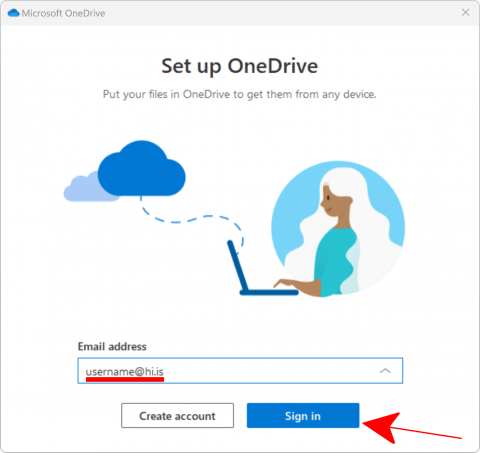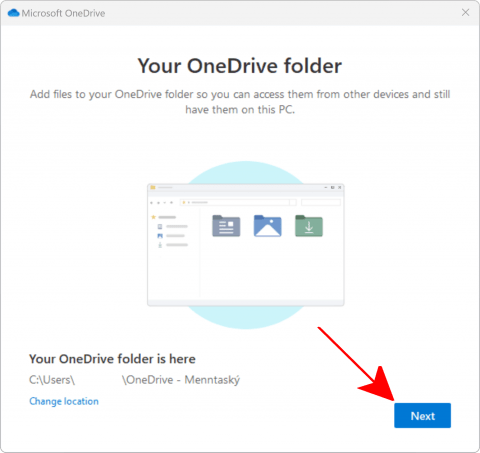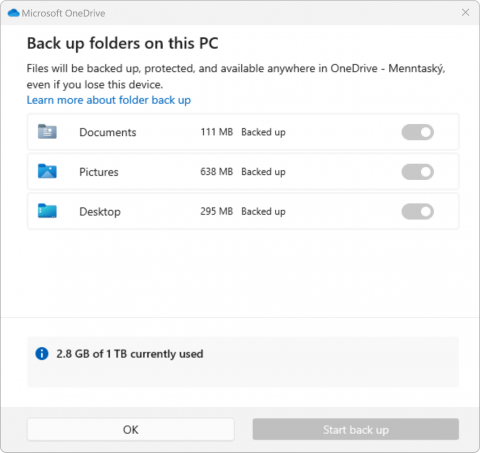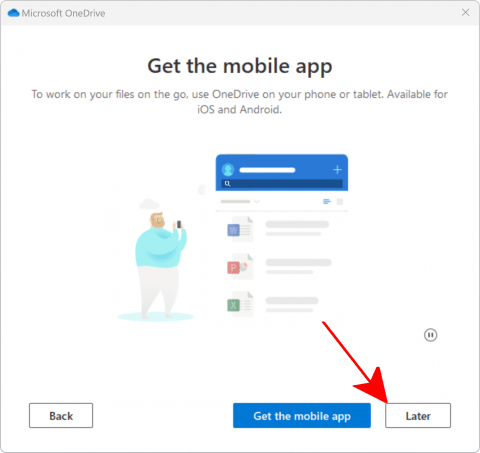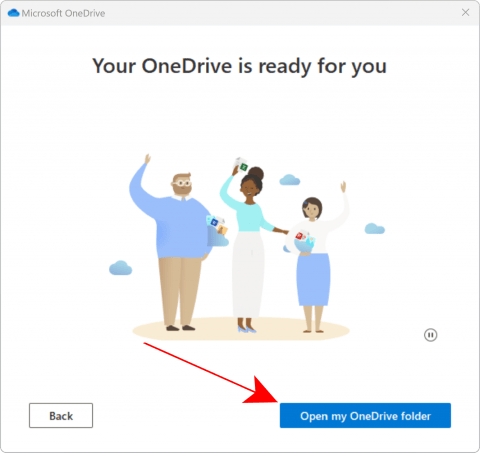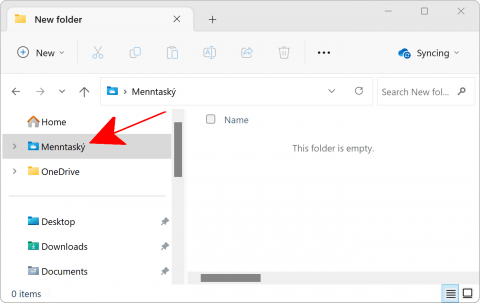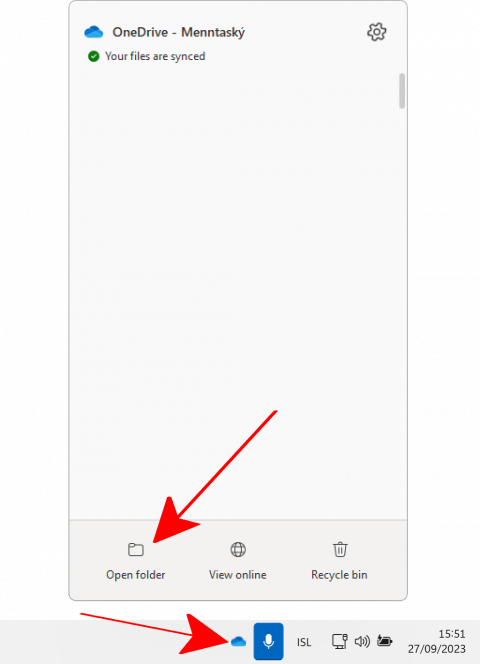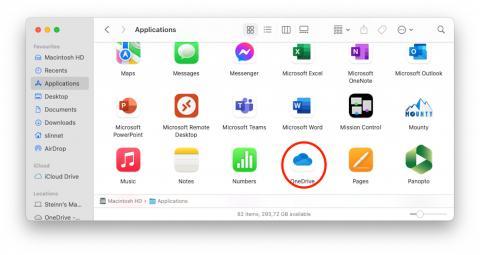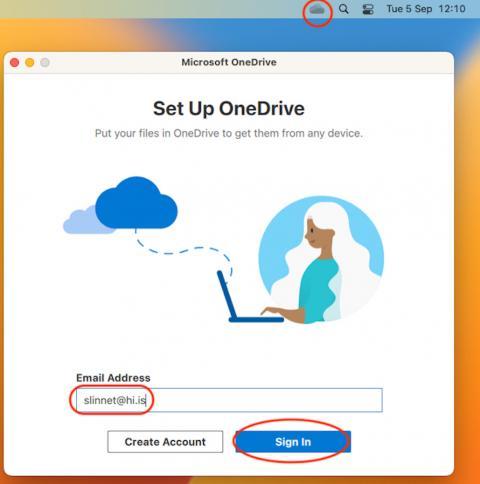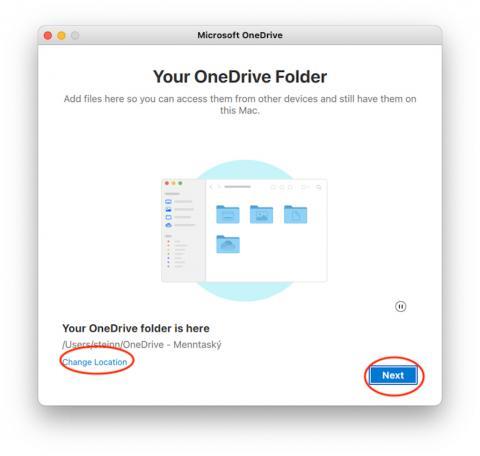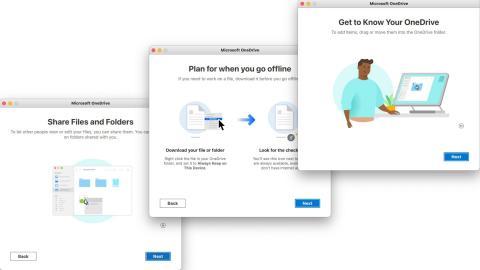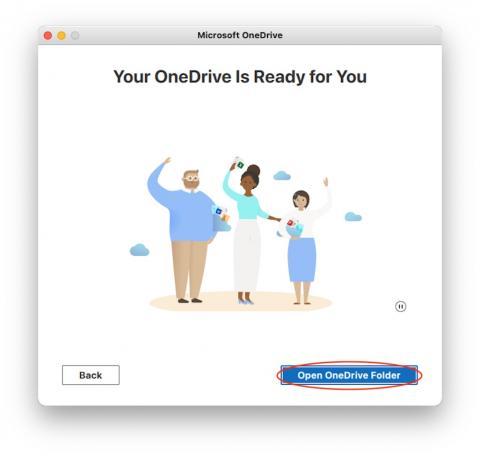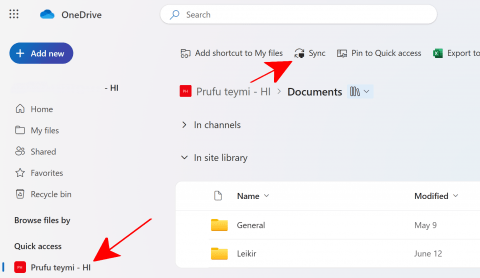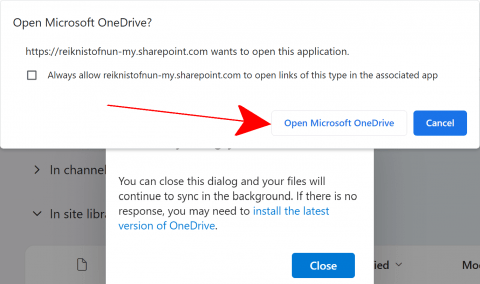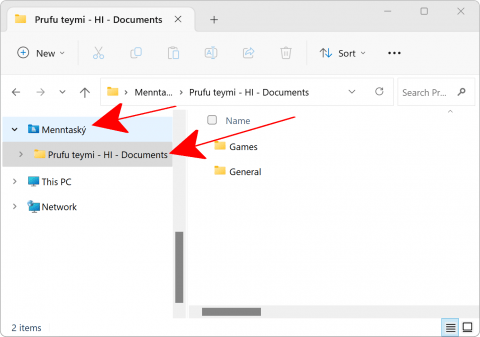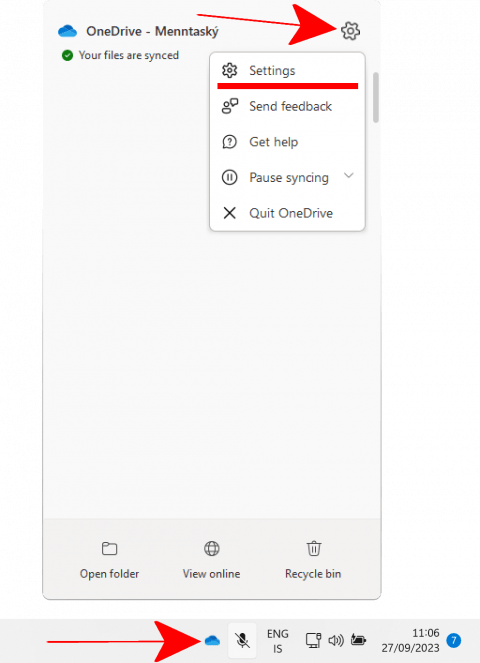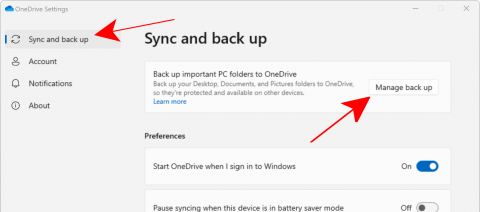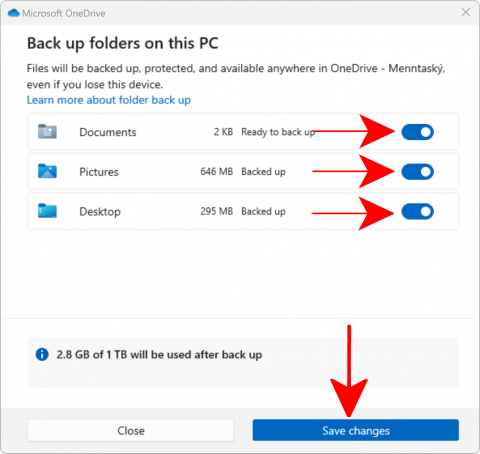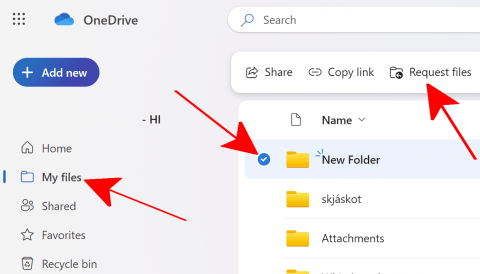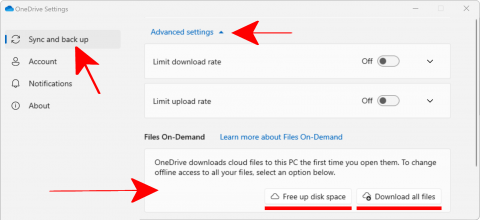Data storage

OneDrive and Teams/SharePoint are included in the Microsoft 365 (Office) package and can also be accessed through onedrive.hi.is and teams.hi.is.
-
All UI users have access to OneDrive cloud storage. The space each user receives is 1TB (1.000 GB).
-
Each group in Teams/SharePoint gets 25TB (25.000GB) of storage.
The difference between OneDrive and Teams/SharePoint is that OneDrive is designed for individual and personal data (which is easy to share), while Teams/SharePoint is a storage area for specially created groups.
We recommend that OneDrive should be used through the web in classrooms.
You can find instructional videos for OneDrive on the Microsoft website (choose work or school).
OneDrive is included with the Microsoft 365 package. It is recommended to install the package first. Onedrive can also be accessed through the web at onedrive.hi.is.
- Start by finding and opening OneDrive on your computer, you can go to the Start button (Windows icon) in the lower left hand corner and write OneDrive:
- Sign in with your UI email address (The one used in Ugla):
- Here you can change the location of where you want to store the data for OneDrive. Click "Next":
- Here you can choose which folders sync automatically to the cloud. Select folders to sync then click "Next":
- If you are offered to install the mobile app click "Later":
- Click "Open my OneDrive folder":
- The OneDrive folder opens. On the right you will notice your OneDrive folder. You work with this folder like any other hard drive or folder and it syncs automatically to your online OneDrive:
- Everything you save or change here is now also available online and other devices that are running OneDrive.
- When onedrive is active a blue cloud will appear in the corner. It can also be opened to check the sync status and to open the OneDrive folder:
OneDrive is included with the Microsoft 365 package. It is recommended to install the package or you can download the app through the App Store. Onedrive can also be accessed through the web at onedrive.hi.is.
- Open the Onedrive app through finder in the applications folder or use the search function to find it:
- In the top right corner you will see the OneDrive cloud icon. Select the icon and sign in with your UI email address:
- Here you can select the location of the OneDrive folder. Documents is chosen by default.
- Here are windows that introduce you too OneDrive. Select next in each window:
- OneDrive will offer you to setup the mobile app. Select "Later":
- OneDrive is now ready. Access your Onedrive folder through "Finder". The name of the folder is "OneDrive - Menntaský". You can open it by selecting "Open OneDrive folder".
Here you can see how you download the onedrive app on smartphones.
- Install the Microsoft 365 app through the Play Store (Android) or App Store (iPhone & iPad) depending on the device.
- Once downloaded open the app and sign in with your UI email address.
Once signed in you can start browsing OneDrive.
Word, Excel, PowerPoint and OneDrive are built into the M365 app however you can also download the OneDrive app on its own through the Play Store (Android) or App Store (iPhone & iPad).
You can always access and share your OneDrive data through a web browser. We do however recommend having onedrive installed on your device.
To access Onedrive on the web go to onedrive.hi.is and sign in with your UI email address. You can also open OneDrive through any Microsoft 365 web page by clicking on the dots in the top left corner
You can view all documents of any team that you have access to on your computer. Below are instructions on how to make these documents visible in Windows. You must have OneDrive installed on your system to follow these instructions.
- Open onedrive.hi.is and sign in.
- Locate the team under "Quick Access". Click on "Sync" to make these files visible on your computer:
- Select "Open Microsoft OneDrive"
- Now you can see your team group files in "File explorer" under "Menntaský". On MacOS you will see them in your OneDrive folder:
If you right click on the folder you can select "Always keep on this device" to store a copy of the data on your computer.
OneDrive offers the option to setup an automatic backup of your Desktop, Documents and Pictures folders to the OneDrive cloud. Please note that this option backups those folders completely and individual files cannot be selected.
To activate this option the following steps must be taken:
- Click on the OneDrive icon. Click the gear and open "Settings":
- Then open the "Sync and back" up tab and click on "Manage back up".
- Select what folders you want to back up to the cloud. After the selection click on "Save changes" to start the automatic backup.
Here is a little overview on what the OneDrive sync symbol represent. For a more complete overview check out Microsoft's webpage.
- Cloud: This data is only stored in the cloud. When you open the file it will download to your device.
- Green unfilled circle with a checkmark: This data is only available on the device.
- Filled green circle: This data is available on the device and in the cloud.
- Red X: This data has not been uploaded due to an error. Sync errors can be seen and fixed by clicking on the OneDrive icon on the taskbar.
- Gray cloud with a line through it on the taskbar: You are not signed into OneDrive. Click on the icon to sign in.
- Arrows in a circle: Onedrive is syncing this data to the cloud.
- A person: This data is being shared with 1 or more people.
- Pause symbol: Onedrive is currently not syncing. Click on the Onedrive symbol on the taskbar and resume syncing.
You can "Request Files" from other users that they can upload directly to a OneDrive or Teams group (set to external) folder without giving them access to the folder.
- Open onedrive.hi.is and go to "My Files" or go to files within the Team
- Check the folder you want to be used as a destination and then click "Request Files"
- Now you only need to state which file you are requesting and send the request to the user/s.
If you want to disable the option to upload files then click on the three dots behind the file. Click manage access" and delete the link.
You can download all of your OneDrive files or delete all locally stored copies of them. (this does not delete the files in the cloud).
- Click on the OneDrive symbol on the taskbar. Click on the gear and open "Settings":
- At the bottom of the "Sync and back up" tab under "Advanced settings" you will find the following options:
- Free up disk space: Here you can delete locally stored copies of your data. (this does not delete the data stored in the cloud).
- Download all files: This downloads and creates a local copy of every file thats stored in the cloud.
Common issues
If you loose any data then you can try the following to recover it.
- OneDrive
- Open onedrive.hi.is and select the recycle bin.
- Open onedrive.hi.is. Click on "My files". Locate the file. Select the three dots behind it and select "Version History".
- You can restore your OneDrive to how it was X days ago if the file is lost and not in the recycle bin. We do however reccomend to first check to see if there is another copy stored on your PC. Open onedrive.hi.is, click on the gear icon and select "Restore your OneDrive"
- SharePoint:
- Open sharepoint.hi.is. Select the Team and select the recycle bin
- Windows:
- Open a file. Select "This PC" on the left side and search for the file.
- I this is a Word/Excel/PowerPoint document then open the app. Select File → Info → Manage Document → Recover Unsaved Documents.
- If this is a Word/Excel/PowerPoint document then open a file. and go to "C:\Users\username\AppData\Local\Microsoft\Office\UnsavedFiles" (replace username with your computer username).
- Check the the recycle bin on the PC.
- MacOS:
- Hold down SHIFT + COMMAND + C and search for the file. If you do not find it then try searching for "autorecovery" in the same location.
- Check the the recycle bin on the PC.
If the path to the file is too long then you won't be able to backup your data to OneDrive. The limit is 255 characters which includes the name of the folders where the document is saved and the name of the file.
